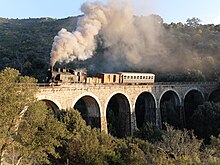
Nuoro is a city and comune (municipality) in central-eastern Sardinia, Italy, situated on the slopes of Mount Ortobene. It is the capital of the province of Nuoro. With a population of 36,347 (2011), it is the sixth-largest city in Sardinia. Its frazione (borough) of Lollove is one of I Borghi più belli d'Italia.

Tempio Pausania is a town of about 14,000 inhabitants in the Gallura region of northern Sardinia, Italy, in the province of Sassari. It is one of I Borghi più belli d'Italia.

Olbia is a city and commune of 60,346 inhabitants in the Italian insular province of Sassari in northeastern Sardinia, Italy, in the historical region of Gallura. Called Olbia in the Roman age, Civita in the Middle Ages and the Terranova Pausania until the 1940s, Olbia has again been the official name of the city since the fascist period.

A heritage railway or heritage railroad is a railway operated as living history to re-create or preserve railway scenes of the past. Heritage railways are often old railway lines preserved in a state depicting a period in the history of rail transport.
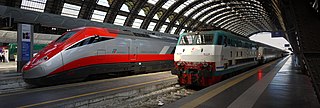
The Italian railway system is one of the most important parts of the infrastructure of Italy, with a total length of 24,227 km (15,054 mi) of which active lines are 16,723 km (10,391 mi). The network has recently grown with the construction of the new high-speed rail network. Italy is a member of the International Union of Railways (UIC). The UIC Country Code for Italy is 83.
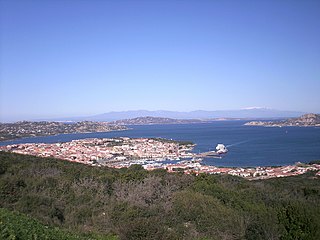
Palau is a comune (municipality) in the province of Sassari, in the Italian region of Sardinia, about 220 kilometres (140 mi) north of Cagliari and about 30 kilometres (19 mi) northwest of Olbia. It was a frazione of the comune of Tempio Pausania until 1959.

Arbatax is the largest hamlet (frazione) of Tortolì, Sardinia, in Italy with a population of almost 5,000 inhabitants.

The Ferrovie della Sardegna, known also as ARST Gestione FdS between 2008 and 2010 and with the abbreviation FdS, was an Italian public company that managed the regional railway network in the island of Sardinia, Italy. In 2010 it was totally integrated with the main regional public transport company, ARST.

Cagliari is the main railway station of the Italian city of Cagliari, the capital of Sardinia. It is owned by the Ferrovie dello Stato, the national rail company of Italy, and is the most important station of its region. The station is sometimes unofficially named Cagliari Centrale and Cagliari Piazza Matteotti. This second name is due to the station's position on Giacomo Matteotti Square.
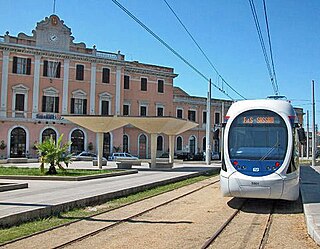
Sassari is the main railway station in the Italian city of Sassari, the second largest city of Sardinia. It is owned jointly by the Ferrovie dello Stato (FS), the national rail company of Italy, and the Ferrovie della Sardegna (FdS).

Sardinia is the second-largest island in the Mediterranean Sea and an autonomous region of Italy. Tourism in Sardinia is one of the fastest growing sectors of the regional economy. The island attracts more than a million tourists from both Italy, from the rest of Europe, and, to a lesser degree, from the rest of the world. According to statistics, tourist arrivals in 2016 were 2.9 million people.

The Sassari–Tempio-Palau railway is a secondary narrow gauge railway line in Sardinia, Italy, managed by the public regional company ARST. A great part of the line was used for touristic purposes from 1997 on, only a limited section from Sassari to Nulvi was still managed for public transport until February 1, 2015. Since that day the whole line has been in use exclusively by and for the Trenino Verde touristic service.
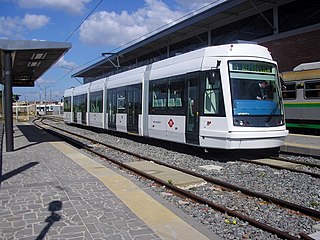
The Cagliari light rail system, commercially known as Metrocagliari, is a two-line light rail system that serves the town of Cagliari and part of its metropolitan area, in Sardinia, Italy. The system was inaugurated in 2008 and has subsequently been expanded to two lines.

Most narrow-gauge railways in Italy were built with Italian metre gauge, which is actually 950 mm because historically the Italian track gauge was defined from the centres of the rail instead of the internationally accepted method of measuring the gauge from the inside edges of the rails. Several metre-gauge lines were built in northern Italy.

ARST S.p.A., known also as Azienda Regionale Sarda Trasporti, is a public company responsible for public transportation in Sardinia, in Italy, owned by the autonomous regional administration of Sardinia.

The railway network of Sardinia includes lines that develop for a total of about 1,038 km in length, of which 430 km with an ordinary gauge and about 608 km narrow gauge, with an average density of 43 m of rail per km2, a figure that drops to 25 m/km2 considering only public transport lines.

